Northern growers, particularly those farming in NSW, are feeling the pinch of widespread flooding and ongoing rain, with wet conditions downgrading grain quality, prolonging harvest and in worst cases, completely wiping out crops.
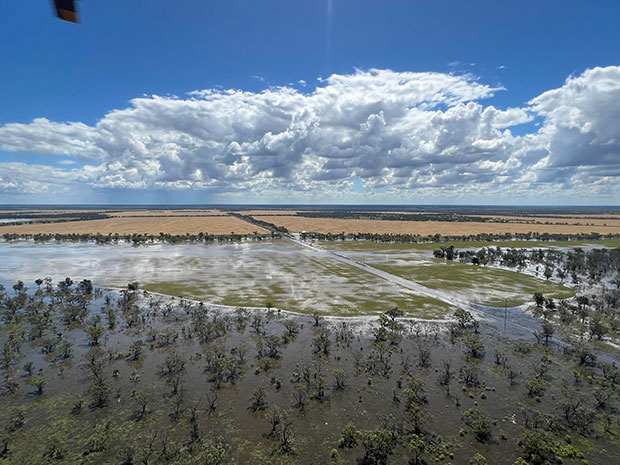
Aerial images showing inundated crops in Walgett. Photo: GRDC
Despite significant, untimely rain throughout October and early November, most growers are still preparing to harvest crops in the coming weeks, much later than usual - however, logistical issues such as road closures, access to storage, washouts, wet paddocks and damaged infrastructure are expected to make this harvest a difficult one.
The Grains Research and Development Corporation (GRDC) has conducted a series of webinars to help growers manage the implications of a wet harvest which can now be viewed online at any time.
GRDC Senior Relations Manager, Gillian Meppem - North, says the organisation has prioritised getting resources out to growers as quickly as possible during this time.
“I don’t think anyone could have anticipated the challenges growers would face at the end of a season that was shaping up to be incredible for most of the northern region,” she says.
“It’s been devastating to hear of crop loss across parts of the region, we’re have focussed delivering tangible advice to growers to help them get harvestable crops off as efficiently and safely as possible. The webinars have extensive tips and information on how to properly store grain, retain seed and harvest canola in wet conditions.”
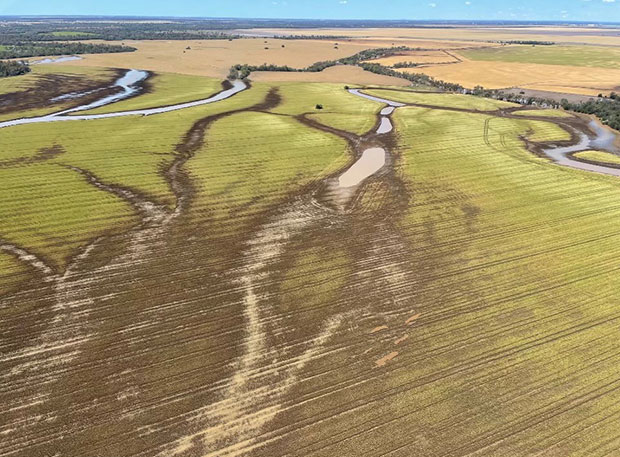
Aerial images showing flooding across the Moree region, which is heavily impacting crops. Photo: Tony Lockrey
AMPS agronomist, Tony Lockrey, says in the Moree district, growers with good drainage or sloped country would still be able to harvest 90 per cent of their crops this harvest, despite the significant amount of rain during October.
“Growers east of the Newell Highway will still be able to harvest most of their crop but they’ll be tip-toeing through it,” he says.
“There have been delays to getting started and also logistical issues of roads being washed out and fences falling down. There’s a lot of infrastructure that will need to be fixed.
“Some growers have been able to get started on their canola and faba beans and have recorded some good yields.”
Areas on the western side of the highway haven’t fared as well, with Mr Lockrey saying about 40 per cent of crops wouldn’t be harvestable.
“That’s regardless of whether crops were ripe or not ripe yet. Flood waters have caused crops to lie down making it extremely difficult to recover at any stage.”
Outlook Ag director, Greg Rummery, Walgett, says the Walgett region has been swamped - with some crops completely inundated from flood water and excessive rain.
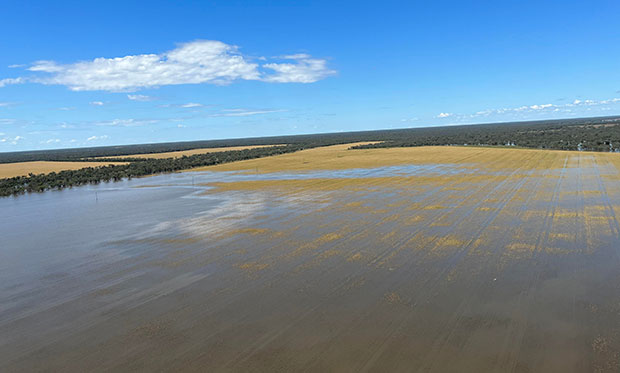
Aerial images showing inundated crops in Walgett. Photo: Supplied
“It’s been a very wet spring, defined by the frequency of rainfall events and the substantial amount of rain these events have produced. On top of that, the Walgett shire has experienced extensive river flooding, with some crops completely underwater,” he says.
“I’m hopeful growers will be able to salvage something from areas that haven’t been entirely inundated with water and crops aren’t fully submerged, but we won’t know until conditions allow, which could be a 4-6 week wait.
“A lot of the region’s harvest will take place in the middle of December to early January, which is extremely late.”
Mr Rummery says on a positive note, some farms north and west of Walgett, that haven’t been impacted by flood waters, have been able to commence harvest.
“We’ve heard some reports of phenomenal grain yields, which just shows how good the season was leading up to the floods,” he says.
“There have been some issues with quality reported though, with low protein, high screenings and weather impacted crops being shot and sprung.
“Some growers have also been able to direct head their canola and have been producing some good yields from that.”
Baan Baa based growers and contractors, Jack and Shaine Maunder have been heavily impacted by flood waters and ongoing rain, with the weather causing a logistical nightmare for their business, which consists of two headers and a spray rig.
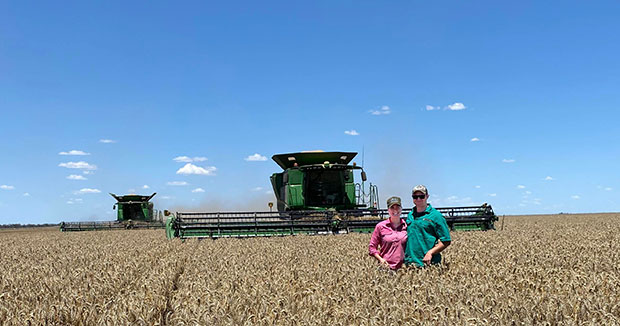
Jack and Shaine Maunder pictured harvesting back in 2020. Photo: Shaine Maunder
“Jack’s family property received 150mm of rain during October. We were fairly lucky in terms of crop loss in that the bulk of the rain fell when the crops were still green - there will be patches that won’t be harvestable, but it could have been a lot worse if the crops were more developed,” Shaine says.
“Our contracting business has certainly felt the impacts of the weather though. We’ve only just gotten our headers onto paddocks in the last week when usually we would have been harvesting for nearly a month.
“At this stage in the season, we would have been harvesting crops in Walgett and making our way back to our district. Instead, we haven’t left our area at all, meaning we’re weeks behind and will most likely lose some of what has been our more consistent work because they’ve lost crops, or are heavily delayed in starting.
“There’s been a lot of sitting on our hands over the past few weeks. Sending our staff out to sit in headers, waiting for the moisture to go down or trying to get around road closures and washouts to get to farms but we’re grateful we’ve at least been able to make a start.”
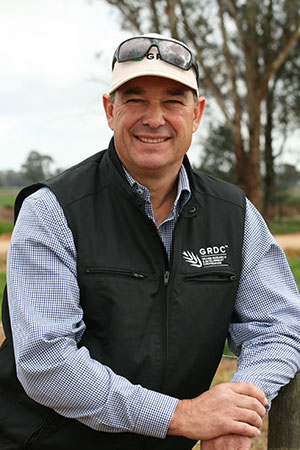 West Wyalong grain grower Roger Bolte said he’ll probably only be able to harvest about 40 per cent of his winter crop after significant annual rainfall. Photo: GRDC
West Wyalong grain grower Roger Bolte said he’ll probably only be able to harvest about 40 per cent of his winter crop after significant annual rainfall. Photo: GRDC
GRDC Northern Region Panel Deputy Chair and West Wyalong grain grower, Roger Bolte, says his family property has received 1000mm of rain so far this year – more than double than their usual annual total of 450mm.
Mr Bolte says growers across his region have been battling the wet conditions for months and the winter cropping area was down compared to usual due to ongoing rain at the start of the year.
Currently, crops across Central NSW all the way down to southern NSW, into Victoria, are being impacted by the ongoing wet conditions and the significant logistical issues they’re causing.
“The eastern side of West Wyalong, including my property, has been completely inundated with water,” he says.
“We had another 90mm of rain yesterday (Sunday, 13 November) which has just been the icing on the cake.
“It’s a case of not knowing what we’ll be able to harvest until the water goes away. We’ll have some crops, like standing Canola, that we’ll be able to take off once we’re able to get on the ground but trafficability is a huge issue for everyone at the moment.
“It’s looking like we’ll only be able to harvest about 40 per cent of what we put in.”
Mr Bolte says there are crops ready for harvest on the western side of West Wyalong but a lot of growers haven’t been able to get a start with the unusually cool conditions and high moisture in crops.
“There will be some growers who will have a good year if they’re able to take their crops off. Commodity prices are promising and there are some terrific looking crops around but they need to be able to get on paddocks to benefit from that.”
MCA Ag director, Paul Castor, Toowoomba, says people were harvesting across the Western Downs and most were having a good run, producing promising yields.
Mr Castor says a lot of growers were still waiting to get on country, especially in southern parts of the Region near Goondiwindi, but they’ll get started when conditions allow.
“We expect there will be some quality issues and there’s been talk of falling numbers but overall, things are looking promising.”
Ms Meppem says GRDC would continue to circulate resources to help growers manage these ongoing wet conditions.

Aerial image showing flooding across the Moree region, which is heavily impacting crops. Photo: Supplied
“Supporting growers is our utmost priority, so if there’s anything we can do to help manage the implications of a difficult harvest, please get in touch,” she says.
“The next few weeks will be a real challenge for growers, so we’re urging everyone to consider managing their fatigue and mental health and to reach out if they need support.”
Growers and advisers can watch GRDC”s latest webinars via the website:
- Storing rain affected grain in a wet harvest
- Keeping rain affected grain for seed
- Harvesting canola in a La Niña: how late can you windrow, and header settings for direct heading
We will continue to share resources across our social media pages, including Facebook, LinkedIn and Twitter.

























































